402a BANDOGGES, GAZEHOUNDS AND ALAUNTS
OF ALAUNTES, BANDOGGES AND GAZEHOUNDS
by David Hancock
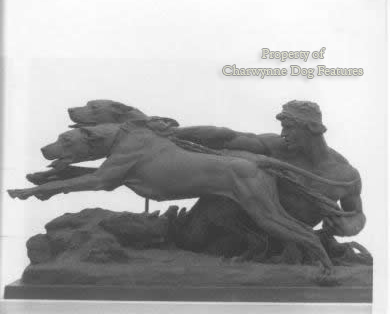 Those three nouns: Alaunte, Bandogge and Gazehound are arguably the most misconstrued of any by dog historians and canine researchers. In recent times, two dog-breeding enthusiasts have, quite separately and unknown to each other, striven to recreate the Alaunt, as if it were once a breed. The other day I saw an advertisement in a magazine for a litter of 'bandogges', as if there was once such a breed. And time and time again you can read of the word gazehound being used as a synonym for sighthound, sharing the same function.
Those three nouns: Alaunte, Bandogge and Gazehound are arguably the most misconstrued of any by dog historians and canine researchers. In recent times, two dog-breeding enthusiasts have, quite separately and unknown to each other, striven to recreate the Alaunt, as if it were once a breed. The other day I saw an advertisement in a magazine for a litter of 'bandogges', as if there was once such a breed. And time and time again you can read of the word gazehound being used as a synonym for sighthound, sharing the same function.
But what are the facts about such dogs? Dealing first of all with the Alaunt. For me, the dog historian with the best understanding of the facts surrounding the Alaunt is the under-rated Scottish writer James Watson. His two volume The Dog of 1906 is a little known masterpiece. Watson was a rarity of his time, a man who understood the development of the dog in the medieval hunting field. The knowledgeable Ash lacked this understanding. The much-quoted Dr Caius was a scholar with no knowledge of dogs but is sadly so often utilised as an authority rather than an erudite collector of information (e.g. for Linnaeus).
The Alaunts were the dogs of the Alans.The Alans were astounding horsemen, so rated as to provide the cavalry for the Roman legions. In a well known inscription, found at Apta on the Durance, the Emperor Hadrian praises and commemorates his 'Borysthenes Alanus Caesareus Veredus' that 'flew' with him over swamps and hills in Tuscany, as he hunted the wild boar. The Romans hunted the wild boar with hunting mastiffs; the Alans would have provided hunting mastiffs as well as horses, their renowned Alaunts. The governors of Milan were once commended 'because...there have sprung up in our region noble Destriers (the war horses of medieval knights) which are held in high estimation. They also reared Alanian d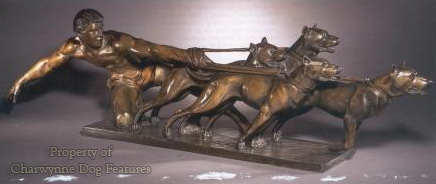 ogs of high stature and wonderful courage.' Chaucer did of course refer to 'Alauns' as big as steers; the type was evidently acknowledged here then.
ogs of high stature and wonderful courage.' Chaucer did of course refer to 'Alauns' as big as steers; the type was evidently acknowledged here then.
As the cavalry for the Roman legions, the Alans have left their mark in Britain. The Avon in Hampshire was once called the Alaun, as was the Alne in Northumberland. Allaway in Scotland comes from this source too. In his very informative The Master of Game of 1410, the renowned hunter Gaston de Foix's words on French dogs are reworked by Edward, second Duke of York. He describes the Alaunt as a hound 'better shaped and stronger for to do harm than any other beast'; he made a distinction between mastiffs and Alaunts. He regarded the latter as seizing dogs, the former as big running mastiffs, for use in the chase. De Foix was the greatest hunter of his time, maintaining a kennel of over a thousand sporting dogs. He would not have blurred mastiffs with Alaunts, he used them in different ways. They had different functions.
In England, the name 'mastiff' wasn't in common use until quite a late date, the end of the 18th century; Osbaldiston, in his famous dictionary, utilises the long-established word of Saxon origin 'bandogge'. Scholars are not always reliable sources of information on breeds or types of dog. Sherwood, in his dictionary, defines a mastiff as an alan. Cotgrave, in his dictionary, records: "Allan: kinde of big, strong, thicke-headed, and short-snowted dog; the brood whereof came first out of Albania (old Epirus)". He is confusing the more recent state of Albania with the ancient country also called Albania, near the Caspian Sea. This latter region is the part of the world where the nomadic Alans originated. But Cotgrave's confusion has not stopped subsequent dog breed researchers from firmly linking Alaunts with the Molossian dog from ancient Epirus, adding further confusion.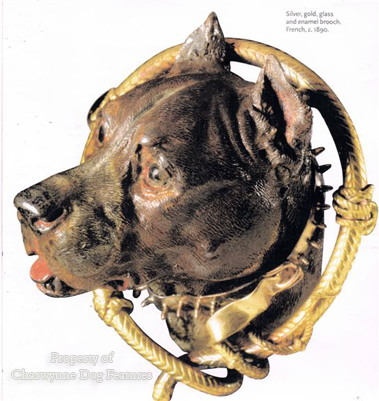
Even worse, Jesse, in his Researches into the History of the British Dog of 1866, like Turbervile before him, presents The Master of Game's descriptions as referring to British dogs, whereas they referred to French ones. But even more misleading to Mastiff researchers is Markham's work in 1616; he tendentiously mistranslated Gratius's Cynegeticon to state that the Romans found 'mastiffs' on reaching the shores of Britain. As the distinguished American historian Jan Libourel has helpfully pointed out, what Gratius actually wrote was: "If you want a good hound, a trip to Britain would almost be worth it. The British dogs may not look much, but for bravery in combat even the famous Molossus does not surpass them." The word mastiff was never used in this much misused quote.
There were three main types of Alaunts: one resembled a strong-headed sighthound, another the Great Dane and a third the classic 'butchers' or holding dog, rather like the Bullmastiff. To seek to recreate a breed called the Alaunt involves the production of a type spanning say the Greyhound, the Cane Corso and the Bulldog; that would be an unlikely achievement! It would be just as difficult to restore the bandogge as a distinct breed and there is comparable confusion about this type. Even as diligent an author as Robert Leighton, in Edwardian times, took the view that the name bandogge or tie-dog referred to a secured guard dog. Sadly most of the revered Victorian writers on dogs cribbed from each other and in so doing cemented myths through sheer repetition. The words of Barnabe Googe in the 16th century linked the word bandogge with a tied-up house dog and, no doubt such a formidable dog made an effective protector of the house---and needed tying up!
Rather than a tethered yard-dog, I believe there is ample evidence to indicate that the bandogge was a seizing dog, leashed during the hunt, until required as a catch-dog, to grip or hold big game which has been chased to near-exhaustion by the running mastiffs, of Great Dane type. This is a time-honoured way of hunting big game with powerful hounds, as the Assyrian bas-relief demonstrates. The 'band' or tie retains the savage dogs until the moment they are needed to risk their lives at the behest of man. There are countless portrayals of this in medieval paintings and engravings. There is an old English ballad of around 1610 which includes the lines: "Half a hundred good band-dogs, Came running over the lee." There is little indication of solitary tied-up yard-dogs in those words.
To recreate the bandogge as a breed would involve combining the anatomy of say the Perro de Presa Canario, the Dogge de Bordeaux, the Belge Matin and the American Staffordshire Terrier. To produce an identifiable breed from such an admixture would be extraordinarily difficult. To advertise the sale of 'bandogges' in national periodicals, as I have seen, is delusion approaching deception. It also plays into the hands of those who view strong-headed muscular dogs as a threat to the community. A recognised breed has clubs and is subject to scrutiny; a breeder of bandogges can sell powerful dogs with 27 inch necks, with no checks on their temperament and little interest in the type of homes they end up in. This is definitely not the time to be replicating dogs of the type once used in barbaric medieval hunts. It attracts the unwanted attention of those who do not have the wit to understand that today's breeds, whether Tosas, Dogos Argentina or Filas Brasileiro, are not canine psychopaths but family dogs with predictable stable temperament.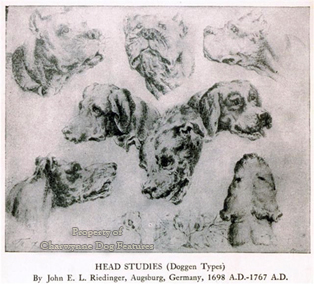
Surprisingly, I have never seen a gazehound advertised for sale but I do see expensive books which use the word gazehound as a synonym for sighthound. I don't believe this is accurate, but persuading sportsmen and writers that this is so, rather like trying to break the inaccurate blurring of molossers with mastiffs, is going to be difficult. So many 'authorities' in so many books record these matters as accepted fact. In his valuable book The Dog in Health and Disease of 1867, the celebrated Stonehenge records: "THE GAZEHOUND -- This breed is now lost, and it is very difficult to ascertain in what respects it differed from the greyhound." I don't believe the great man got that right. It is not justifiable to refer to this type as a breed; the sighthound has never been a breed.
In his Of English Dogs of 1576, the much-quoted Dr Caius, wrote on the gazehound, which he listed separately from the Greyhound, although he himself was neither an expert on dogs nor a sportsman. He recorded: "Horsemen use them more than footmen, in the intent that they might provoke their horses to a swift gallop...and that they might accustom their horse to leap over hedges and ditches, without stop or stumble..." He described their modus operandi as that of "never ceaseth until he hath wearied the beast to death." Both these quotes hardly represent an account of a sighthound at work. It is a good description of par force hunting, in which medieval huntsmen rode hard, rather as in steeplechasing, after hounds which hunted by sight and scent. Bewick in his History of Quadrupeds of 1790 drew on Caius's words, listing the gazehound, as well as, separately, types like the Greyhound, the Highland Greyhound and the Irish Greyhound.
Par force hunting fell out of favour in Britain, the slower 'hunting cunning' using scenthounds replacing it. But boarhounds and staghounds across mainland Europe were employed in this style of hard-pursuit quarry-hunting for much longer. In otter hunting to 'gaze' meant to view the otter. Shakespeare wrote of "...the poor frighted deer, that stands at gaze..." The word 'gaze' clearly had a more precise meaning than merely 'see' or 'sight'; it has a Scandinavian origin and meant to fix one's eye on an object. Par force hounds located their prey by using scent and, once they caught sight of it, fixed their eye on it and went 'like the clappers', wearying the beast to death, as Caius recorded.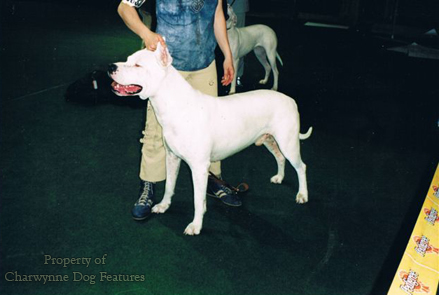
But does it really matter if words like alaunt, bandogge and gazehound are used too loosely? I believe it does if you want to understand the function of your breed and why its anatomy was constructed in the way it originally was. No dog was ever specifically bred to be tied up in a yard. But for several millennia, dogs were purposefully developed to pull down big game and help to feed their owners. Many of these were killed by their quarry; they were remarkably brave and amazingly determined, the latter point never lost on anyone training a Bullmastiff! I suspect that the Dalmatian is built the way it is because it was a hunting dog, a par force hound. The link with Dalmatia has always been tenuous; I prefer the theory in which it was once called 'Dama-chien' or deer-dog. The type certainly predates the elegant horse-drawn carriage. To me it looks like a lightweight hound, with a good nose and the grace of a steeplechaser. This is a real gazehound.
These terms have been misunderstood because researchers seek breed origins when they should be looking back for a function. 'Alauntes gentle' were employed as gazehounds; 'alauntes of the butcheries' were employed as bandogges. Understanding a breed is for me a matter of identifying what the function of that type originally was and what kind of physique was demanded by that role. Only then can you truly appreciate why the upper arm needs to be the same length as the forearm, the degree of bend at the stifle and the muzzle length. Breed function matters!